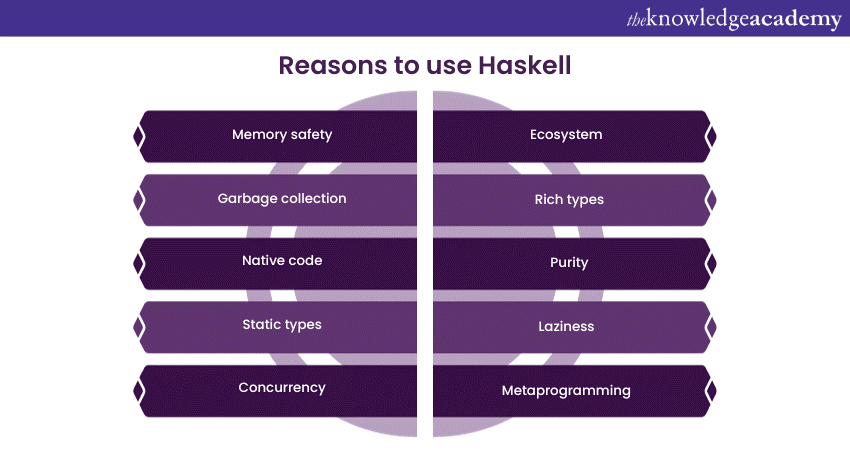We may not have the course you’re looking for. If you enquire or give us a call on +64 98874342 and speak to our training experts, we may still be able to help with your training requirements.
Training Outcomes Within Your Budget!
We ensure quality, budget-alignment, and timely delivery by our expert instructors.

Haskell, a programming language developed in the late 1980s, is distinguished by its strong focus on correctness and conciseness. Boasting a robust statically typed system with advanced type inference, Haskell catches errors early in development. It incorporates lazy evaluation for enhanced modularity, immutability for clarity, and powerful abstractions like pattern matching and monads.
Haskell's functional nature, strong type system, and emphasis on mathematical principles make it suitable for a wide range of applications. Read more to learn more about What is Haskell Used For through this blog!
Table of Contents
1) What is Haskell?
2) 10 Reasons to Use Haskell
a) Memory safety
b) Garbage collection
c) Native code
d) Static types
e) Concurrency
f) Ecosystem
3) Conclusion
What is Haskell?
Haskell is a statically typed, purely functional programming language known for its emphasis on correctness and conciseness. Developed in the late 1980s, it features a powerful type of system, lazy evaluation, and immutable data. Haskell's static typing and type inference catch errors early in development, contributing to robust software. The language supports high-level abstractions like pattern matching, monads, and algebraic data types, fostering expressive and modular code. Compiled to native machine code by the Glasgow Haskell Compiler (GHC), Haskell finds applications in academia, research, and industry, where its active community contributes to a rich ecosystem of libraries and tools.
10 Reasons to Use Haskell
The following are the ten reasons to use Haskell:

1) Memory safety
Memory safety is critical in Software Development, mainly when dealing with languages like C and C++ that employ manual memory management. The manual allocation and deallocation of memory in these languages frequently give rise to a host of problems, including but not limited to buffer overflows, use-after-free errors, and memory leaks. These issues pose significant threats to the security of a software system, creating vulnerabilities that malicious actors can exploit.
One prominent example of such vulnerabilities is highlighted in the Common Weakness Enumeration (CWE) as CWE-416: Use After Free. This specific weakness occurs when a program continues to use a pointer that has been freed, potentially leading to unpredictable and hazardous behaviour. Instances of this nature underscore the tangible risks associated with manual memory management.
In contrast to languages like C and C++, Haskell employs automatic memory management, significantly mitigating the risk of encountering memory-related problems. Automated memory management, often facilitated by garbage collection, alleviates the burden on developers to handle memory allocation and deallocation meticulously. As a result, Haskell provides a more robust and secure environment for software development.
2) Garbage collection
Garbage collection is a pivotal mechanism for attaining memory safety in programming languages. It presents a more prevalent approach compared to static lifetime checking, a feature notably employed in languages like Rust. Garbage collection involves the automatic identification and reclamation of memory no longer in use, addressing issues such as memory leaks, buffer overflows, and use-after-free errors.
In contrast to static lifetime checking, which requires the programmer to manage the allocated memory's lifespan explicitly, garbage collection provides a more relaxed and automated solution. This computerised memory management is particularly beneficial for developers, reducing the burden of manually handling memory deallocation and minimising the likelihood of memory-related bugs.
While garbage collection introduces some trade-offs, such as making Haskell less ideal for real-time systems like computer games due to potential pauses during garbage collection cycles, it offers flexibility that contributes to better code abstractions. The more forgiving nature of garbage collection allows developers to focus on high-level logic and design, promoting an environment conducive to creating expressive and maintainable code.
Are you interested in learning about the different Programming Languages? Register now for our Programming Training!
3) Native code
In contrast to interpreted languages like Python, Ruby, JavaScript, and Lua, Haskell takes a distinctive approach by being compiled ahead of time directly into native machine code. This means that before execution, the Haskell code is transformed into machine-level instructions that the computer's hardware can now understand and execute. The GHC (Glasgow Haskell Compiler) plays a pivotal role in this process and distinguishes itself through its exceptional optimisation capabilities. The compiler is adept at analysing and restructuring the Haskell code to enhance its performance, generating highly efficient executables. This efficiency is crucial for applications with demanding computational requirements, such as high-throughput data processing.
4) Static types
Compared to Java and JavaScript, Haskell incorporates a robust type-checking mechanism throughout the development phase. This proactive approach serves as a formidable defence against numerous bugs, detecting and rectifying issues early in the development cycle. By doing so, Haskell contributes to creating a more dependable product well before it is exposed to end-users or undergoes scrutiny in the quality assurance department.
Moreover, implementing static types in Haskell allows developers to delve into the intricacies of the data model encoded within these types. This facilitates a more profound comprehension of the software's internal structure and enhances the developer's grasp of the intricacies of the business domain that the software is intended to address. The clarity offered by static types is a valuable aid in deciphering the relationships and interactions within the data, providing a tangible advantage in crafting well-informed, resilient, and business-aligned software solutions.
5) Concurrency
While concurrency poses challenges in many languages, Haskell simplifies the process. Green threads, excellent libraries like async and stm, and the prevalence of pure functions make writing concurrent applications in Haskell a pleasurable experience rather than a headache.
Do you want to learn more about Haskell Programming Language? Sign up for our Haskell Programming Training!
6) Ecosystem
Hackage is a central hub, a consolidated repository for open-source Haskell software, offering an impressive array of over 14,000 packages. This extensive collection encompasses diverse libraries, tools, and resources from the vibrant Haskell community. In tandem, Stackage complements Hackage by curating a carefully selected assortment of package versions. This curation process ensures a harmonious coexistence of libraries, guaranteeing compatibility and stability across the Haskell ecosystem. Within Stackage's meticulously maintained collection, there are over 2,000 packages that undergo rigorous scrutiny to uphold quality standards. The emphasis on maintenance contributes to the reliability of these packages, fostering a dependable foundation for developers to build upon. This curated approach streamlines the development process and promotes seamless integration of various components within Haskell projects.
7) Rich types
Unlike Java or Go, where static types may seem cumbersome, Haskell's type system is robust, serving as a convenience. With support for algebraic data types, parametric polymorphism, class-based (ad-hoc) polymorphism, type families, type equalities, existential quantification, higher-rank polymorphism, kind polymorphism, runtime type inspection, Haskell provides a versatile toolset for writing statically typed programs.
8) Purity
Purity lies at the core of Haskell's design philosophy, anchoring itself in using pure functions and immutable data structures. This foundational approach has repeatedly demonstrated its significance in developing accurate, error-free software.
The essence of Haskell's commitment to purity is reflected in the emphasis on pure functions, which, by definition, produce the same output for a given set of inputs without relying on or modifying the external state. This predictability eliminates the uncertainties associated with managing the global state, offering a clear and deterministic path for software execution.
Immutable data structures further enhance this commitment by ensuring that once a piece of data is created, it remains unaltered throughout its lifecycle. This immutability eliminates the risks and complexities of mutable data, where changes can propagate unpredictably across the codebase. Haskell's steadfast adherence to immutability fosters stability, making it easier to reason about the behaviour of programs and reducing the likelihood of unintended consequences.
Enhance your knowledge of Python Django with our Python Django Training!
9) Laziness
Laziness is a fundamental characteristic deeply embedded in the DNA of Haskell since its inception. At its core, Haskell was conceptualised as a language that embraces laziness, and this commitment to lazy evaluation stands as its defining feature. Lazy evaluation fundamentally alters the traditional approach to computation, as it allows Haskell to defer the execution of computations until the precise moment when their results are required.
The deferred nature of computation in Haskell brings many advantages, significantly impacting the development process. One notable benefit lies in refactoring, where laziness facilitates a more flexible and seamless approach to modifying and rearranging code. Because computations are only carried out when their outcomes become necessary, developers can change the codebase with a reduced risk of unintended consequences. This ease of refactoring becomes a powerful asset in the evolution and maintenance of Haskell code.
10) Metaprogramming
Metaprogramming in Haskell involves leveraging the powerful capabilities of Template Haskell to inspect and manipulate a program's Abstract Syntax Tree (AST). This sophisticated feature allows developers to delve into the structure of their code at compile time, opening possibilities for code generation and manipulation.
By supporting the examination of the AST, Haskell's metaprogramming capabilities enable a deeper understanding of the code's structure and composition. Template Haskell provides a mechanism for introspection, allowing developers to programmatically analyse the structure of their programs before they are fully compiled. This insight into the AST grants control and customisation beyond what is typically achievable during runtime.
One key advantage of Template Haskell is its ability to facilitate compile-time evaluation. This means certain computations and operations can be performed at the compilation stage rather than runtime. This can lead to performance improvements, as computations that would traditionally occur during program execution are instead precomputed during the compilation process.
Learn the architecture and data model of Cassandra with our Apache Cassandra Training. Sign up now!
Conclusion
Haskell is a high-level, purely functional programming language known for its static, solid typing, easy evaluation, and mathematical elegance. Ideal for complex computations and ensuring code reliability. We hope that you understood What is Haskell Used For through our blog!
Learn some advanced techniques in web development with our ReactJS Course. Register now!
Frequently Asked Questions
Upcoming Programming & DevOps Resources Batches & Dates
Date
 Haskell Programming
Haskell Programming
Thu 23rd Jan 2025
Thu 10th Apr 2025
Thu 15th May 2025
Thu 17th Jul 2025
Thu 4th Sep 2025
Thu 13th Nov 2025







 Top Rated Course
Top Rated Course



 If you wish to make any changes to your course, please
If you wish to make any changes to your course, please


